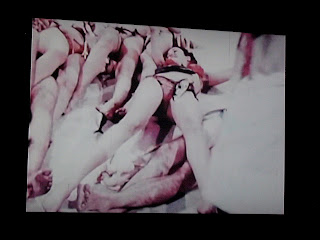“Who am I supposed to vote for? Andrew Cuomo and who else?”
A tall twenty-something man with black-rimmed glasses is speed-walking and speaking urgently into his phone. I follow him past black iron gates plastered with white signs that say “VOTE HERE” in 4 different languages.
Unfortunately, I don’t follow politics as closely as I should. I could understand the stranger’s confusion on General Election Day. And I was apprehensive about going to the polling site – was I going to get kicked out? Would anyone speak to me? I didn’t know what I was going to find.
We arrive at poll site M0319: 189 Allen Street. A 17-story public housing development called the Rafael Hernandez Houses.
From 4:30 p.m. to 6:00 p.m., people trickle in the room with its cinder block walls and tile floors. There are a handful of students. Others are dressed in work clothes, suits and clattering heels. Sometimes there were only three or four people in the room; other times the room was filled with dozens.
There are a few tables arranged around the room with a couple of people at each one. In the center of the space are makeshift tables with compartments; they are equipped with lighting and sheets of paper that outlined the voting process. It seemed simple enough. Get your ballot. Mark your ballot. Scan your ballot?
And then I saw the
new polling machines. No more lever machines. In the corner of the room sat 3 black machines and 1 gray one for those with disabilities.
Well, it seemed that people were coming out to vote or working the sites for different reasons. Lewis Chio, 21, and Koey Chio, 23, were part-time workers who needed the money. Student Peter Valdez, 19, who goes to Hunter, wanted to “keep the general ideal of the democrats in power.” Kristina Wels, 36, director of Caedmon School, was passionate about gay marriage and economy issues.
But it seemed that everyone I spoke to approved of the new polling system. Or at least saw its potential.
“The changes are great,” Poll Inspector Juan Ayala, 24, said. “The money you’re going to save when one of these break? Easy. It’s a computer you can reset and reprogram. When the old machines broke, you had to send it in because nobody on site could fix it. They took up so much room. And now it’s just simpler. Younger people, our generation, find it easier. Older people might not, but at the same time, they have to catch up.”
Milagros Abreu, 55, said she found it to be surprisingly easy. National Grid employee Feisal Ahmad, 33, also appreciated the quickened process. Wels thought it was about time they had a new voting procedure.
But she thinks the issue that probably has to be addressed more than anything is actually getting people to come out and vote.
“I can imagine people who work the night shift who can’t make it,” said Wels. “Or those who have more than 1 kid. I talked to a few mothers at my school and they wished they could vote, but they have 3 kids or they have to pick them up from soccer practice, and it’s just too hard. If you could do it at home, it would be a much more fair distribution of who is actually voting in the election.”
But until then, it seems that voters and workers hope the new system doesn't prevent anyone from coming out to vote.
“Older people might be more apprehensive to go out – some might hear ‘technology’ and forget it,” said Valdez. “Hopefully they’ll get used to it. If you feel any sort of responsibility or at any point wanted something to change, you would bring it about by voting.”
“Technology might just seem a little hectic at first, but by next September, everyone will have it down,” Poll Coordinator Janet Guzman, 65, said. “They have to. It’s more than important to vote. You have a voice, and without the voice, things would never change.”








